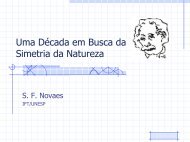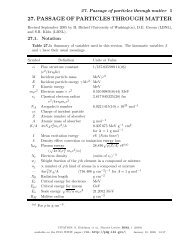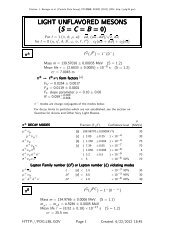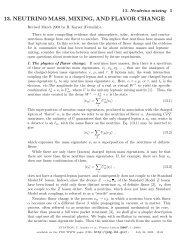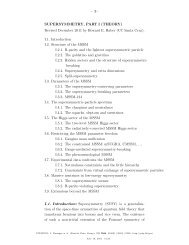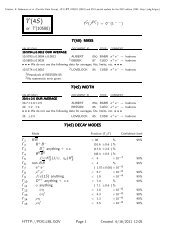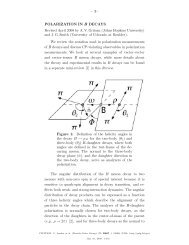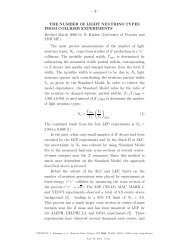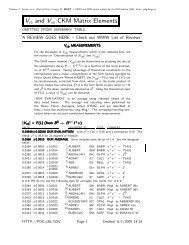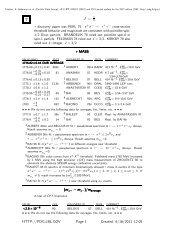11. THE CKM QUARK-MIXING MATRIX - Particle Data Group
11. THE CKM QUARK-MIXING MATRIX - Particle Data Group
11. THE CKM QUARK-MIXING MATRIX - Particle Data Group
Create successful ePaper yourself
Turn your PDF publications into a flip-book with our unique Google optimized e-Paper software.
<strong>11.</strong> <strong>CKM</strong> quark-mixing matrix 1<br />
<strong>11.</strong> <strong>THE</strong> <strong>CKM</strong> <strong>QUARK</strong>-<strong>MIXING</strong> <strong>MATRIX</strong><br />
Written January 2006 by A. Ceccucci (CERN), Z. Ligeti (LBNL), and Y. Sakai (KEK).<br />
<strong>11.</strong>1. Introduction<br />
The masses and mixings of quarks have a common origin in the Standard Model (SM).<br />
They arise from the Yukawa interactions with the Higgs condensate,<br />
L Y = −Yij d QI Li φdI Rj − Y ij u QI Li ɛφ∗ u I Rj +h.c., (<strong>11.</strong>1)<br />
where Y u,d are 3 × 3 complex matrices, φ is the Higgs field, i, j are generation labels, and<br />
ɛ is the 2 × 2 antisymmetric tensor. Q I L are left handed quark doublets, and dI R and uI R<br />
are right handed down- and up-type quark singlets, respectively, in the weak-eigenstate<br />
basis. When φ acquires a vacuum expectation value, 〈φ〉 =(0,v/ √ 2), Eq. (<strong>11.</strong>1) yields<br />
mass terms for the quarks. The physical states are obtained by diagonalizing Y u,d by four<br />
unitary matrices, V u,d<br />
L,R ,asM f diag = V f L Y f V f†<br />
R (v/√ 2), f = u, d. As a result, the charged<br />
current W ± interactions couple to the physical u Lj and d Lk quarks with couplings given<br />
by<br />
⎛<br />
V <strong>CKM</strong> ≡ VL u V d†<br />
L<br />
= ⎝ V ⎞<br />
ud V us V ub<br />
V cd V cs V cb<br />
⎠ . (<strong>11.</strong>2)<br />
V td V ts V tb<br />
This Cabibbo-Kobayashi-Maskawa (<strong>CKM</strong>) matrix [1,2] is a 3 × 3 unitary matrix. It<br />
can be parameterized by three mixing angles and a CP-violating phase. Of the many<br />
possible parameterizations, a standard choice is [3]<br />
⎛<br />
c 12<br />
c 13<br />
s 12<br />
c 13<br />
s 13<br />
e −iδ ⎞<br />
V = ⎝ −s 12<br />
c 23<br />
−c 12<br />
s 23<br />
s 13<br />
e iδ c 12<br />
c 23<br />
−s 12<br />
s 23<br />
s 13<br />
e iδ s 23<br />
c ⎠ 13<br />
, (<strong>11.</strong>3)<br />
s 12<br />
s 23<br />
−c 12<br />
c 23<br />
s 13<br />
e iδ −c 12<br />
s 23<br />
−s 12<br />
c 23<br />
s 13<br />
e iδ c 23<br />
c 13<br />
where s ij =sinθ ij , c ij =cosθ ij ,andδ is the KM phase [2] responsible for all CP-violating<br />
phenomena in flavor changing processes in the SM. The angles θ ij can be chosen to lie in<br />
the first quadrant, so s ij ,c ij ≥ 0.<br />
It is known experimentally that s 13 ≪ s 23 ≪ s 12 ≪ 1, and it is convenient to exhibit<br />
this hierarchy using the Wolfenstein parameterization. We define [4–6]<br />
s 12 = λ =<br />
|V us |<br />
√<br />
|Vud | 2 + |V us | 2 ,<br />
∣ s 23 = Aλ 2 = λ<br />
V cb ∣∣∣<br />
∣ ,<br />
V us<br />
s 13 e iδ = V ∗ ub = Aλ3 (ρ + iη) = Aλ3 (¯ρ + i¯η) √ 1 − A 2 λ 4<br />
√<br />
1 − λ 2 [1 − A 2 λ 4 (¯ρ + i¯η)] . (<strong>11.</strong>4)<br />
These ensure that ¯ρ + i¯η = −(V ud Vub ∗ )/(V cdVcb ∗ ) is phase-convention independent and the<br />
<strong>CKM</strong> matrix written in terms of λ, A, ¯ρ and ¯η is unitary to all orders in λ. The definitions<br />
of ¯ρ, ¯η reproduce all approximate results in the literature. E.g., ¯ρ = ρ(1 − λ 2 /2+...)and<br />
we can write V <strong>CKM</strong> to O(λ 4 ) either in terms of ¯ρ, ¯η or, traditionally,<br />
⎛<br />
V = ⎝ 1 − λ2 /2 λ Aλ 3 ⎞<br />
(ρ − iη)<br />
−λ 1 − λ 2 /2 Aλ 2 ⎠ + O(λ 4 ) . (<strong>11.</strong>5)<br />
Aλ 3 (1 − ρ − iη) −Aλ 2 1<br />
CITATION: W.-M. Yao et al., Journal of Physics G 33, 1 (2006)<br />
available on the PDG WWW pages (URL: http://pdg.lbl.gov/) August 30, 2006 10:12
2 <strong>11.</strong> <strong>CKM</strong> quark-mixing matrix<br />
Figure <strong>11.</strong>1:<br />
Sketch of the unitarity triangle.<br />
The <strong>CKM</strong> matrix elements are fundamental parameters of the SM, so their precise<br />
determination is important. The unitarity of the <strong>CKM</strong> matrix imposes ∑ i V ijVik ∗ = δ jk<br />
and ∑ j V ijVkj ∗ = δ ik. The six vanishing combinations can be represented as triangles in<br />
a complex plane, of which the ones obtained by taking scalar products of neighboring<br />
rows or columns are nearly degenerate. The areas of all triangles are the same, half of<br />
the Jarlskog invariant, J [7], which is a phase-convention independent measure of CP<br />
violation, Im [ V ij V kl Vil ∗V<br />
kj<br />
∗ ] ∑ = J m,n ε ikmε jln .<br />
The most commonly used unitarity triangle arises from<br />
V ud Vub ∗ + V cd Vcb ∗ + V td Vtb ∗ =0, (<strong>11.</strong>6)<br />
by dividing each side by the best-known one, V cd Vcb ∗ (see Fig. 1). Its vertices are exactly<br />
(0, 0), (1, 0) and, due to the definition in Eq. (<strong>11.</strong>4), (¯ρ, ¯η). An important goal of<br />
flavor physics is to overconstrain the <strong>CKM</strong> elements, and many measurements can be<br />
conveniently displayed and compared in the ¯ρ, ¯η plane.<br />
Processes dominated by loop contributions in the SM are sensitive to new physics<br />
and can be used to extract <strong>CKM</strong> elements only if the SM is assumed. In Sec. <strong>11.</strong>2 and<br />
<strong>11.</strong>3 we describe such measurements assuming the SM, and discuss implications for new<br />
physics in Sec. <strong>11.</strong>5.<br />
<strong>11.</strong>2. Magnitudes of <strong>CKM</strong> elements<br />
<strong>11.</strong>2.1. |V ud | :<br />
The most precise determination of |V ud | comes from the study of superallowed 0 + → 0 +<br />
nuclear beta decays, which are pure vector transitions. Taking the average of the nine<br />
most precise determinations [8,9] yields [10]<br />
|V ud | =0.97377 ± 0.00027. (<strong>11.</strong>7)<br />
August 30, 2006 10:12
<strong>11.</strong> <strong>CKM</strong> quark-mixing matrix 3<br />
The error is dominated by theoretical uncertainties stemming from nuclear Coulomb<br />
distortions and radiative corrections. A recent measurement of 46 V performed using<br />
an atomic Penning trap method [9] deviates by 2.7 standard deviations from the<br />
average and may indicate a need to remeasure superallowed 0 + → 0 + transitions with<br />
modern atomic physics techniques. A precise determination of |V ud | is also obtained<br />
from the measurement of the neutron lifetime. The theoretical uncertainties are very<br />
small but the determination is limited by the knowledge of the ratio of the axialvector<br />
and vector couplings, g A = G A /G V [10]. The PIBETA experiment [11] has<br />
improved the measurement of the π + → π 0 e + ν branching ratio to 0.6%, and quote<br />
|V ud | =0.9728 ± 0.0030, in agreement with the more precise results listed above. The<br />
interest in this measurement is that the determination of |V ud | is very clean theoretically,<br />
because it is a pure vector transition and is free from nuclear structure uncertainties.<br />
<strong>11.</strong>2.2. |V us | :<br />
The magnitude of V us has been extracted traditionally from semileptonic kaon decays.<br />
Significant progress on the experimental side has taken place during the last two years.<br />
After a high statistics measurement of B(K + → π 0 e + ν) [12], a suite of measurements of<br />
neutral kaon branching ratios [13–15], form factors [16], and lifetime [17] followed. An<br />
early value of f + (0) = 0.961 ± 0.008 [18] is still broadly accepted [10,19]. It yields from<br />
the kaon semileptonic decay rate<br />
|V us | =0.2257 ± 0.0021. (<strong>11.</strong>8)<br />
A word of caution is in order, since other calculations of f + (0) [20,21] differ by as much<br />
as 2%, with uncertainties around 1%.<br />
Other determinations of |V us | involve leptonic kaon decays, hyperon decays, and<br />
τ decays. The calculation of the ratio of the kaon and pion decay constants enables<br />
one to extract |V us /V ud | from K → µν(γ) andπ → µν(γ), where (γ) indicates that<br />
radiative decays are included [22]. The KLOE measurement of the K + → µ + ν(γ)<br />
branching ratio [23], combined with the unquenched lattice QCD calculation,<br />
f K /f π =1.198 ± 0.003 +0.016<br />
−0.005 [24], leads to |V us| =0.2245 +0.0012<br />
−0.0031<br />
, where the accuracy is<br />
limited by the knowledge of the ratio of the decay constants. Hereafter, the first error is<br />
statistical and the second is systematic, unless mentioned otherwise. The determination<br />
from hyperon decays was recently updated [25]. These authors focus on the analysis<br />
of the vector form factor, protected from first order SU(3) breaking effects by the<br />
Ademollo-Gatto theorem [26], and treat the ratio between the axial and vector form<br />
factors g 1 /f 1 as experimental input, thus avoiding first order SU(3) breaking effects in<br />
the axial-vector contribution. They find |V us | =0.2250 ± 0.0027, although this does not<br />
include an estimate of the theoretical uncertainty due to second order SU(3) breaking,<br />
contrary to Eq. (<strong>11.</strong>8). Concerning hadronic τ decays to strange particles, the latest<br />
determinations based on OPAL or ALEPH data also yields consistent results [27] with<br />
accuracy around 0.003.<br />
August 30, 2006 10:12
4 <strong>11.</strong> <strong>CKM</strong> quark-mixing matrix<br />
<strong>11.</strong>2.3. |V cd | :<br />
The magnitude of V cd can be extracted from semileptonic charm decays if theoretical<br />
knowledge of the form factors is available. Recently, the first three-flavor unquenched<br />
lattice QCD calculations for D → Klν and D → πlν have been published [28]. Using<br />
these estimates and the isospin-averaged charm semileptonic width measured by CLEO-c,<br />
one obtains |V cd | =0.213 ± 0.008 ± 0.021 [29], where the first uncertainty is experimental<br />
and the second is from the theoretical error of the form factor.<br />
This determination is not yet as precise as the one based on neutrino and antineutrino<br />
interactions. The difference of the ratio of double-muon to single-muon production by<br />
neutrino and antineutrino beams is proportional to the charm cross section off valence<br />
d-quarks, and therefore to |V cd | 2 times the average semileptonic branching ratio of charm<br />
mesons, B µ . The method was used first by CDHS [30] and then by CCFR [31,32] and<br />
CHARM II [33]. Averaging these results is complicated, not only because it requires<br />
assumptions about the scale of the QCD corrections, but also because B µ is an effective<br />
quantity, which depends on the specific neutrino beam characteristics. Given that no new<br />
experimental input is available, we quote the average provided in the previous edition of<br />
this review, B µ |V cd | 2 =(0.463 ± 0.034) × 10 −2 [3]. Analysis cuts make these experiments<br />
insensitive to neutrino energies smaller than 30 GeV. Thus, B µ should be computed using<br />
only neutrino interactions with visible energy larger than 30 GeV. A recent appraisal [34]<br />
based on charm production fractions measured in neutrino interactions [35,36] gives<br />
B µ =0.088 ± 0.006. <strong>Data</strong> from the CHORUS experiment [37] are now sufficiently precise<br />
to extract B µ directly, by comparing the number of charm decays with a muon to the<br />
total number of charmed hadrons found in the nuclear emulsions. Requiring the visible<br />
energy to be larger than 30 GeV, CHORUS finds B µ =0.085 ± 0.009 ± 0.006. To extract<br />
|V cd |, we use the average of these two determinations, B µ =0.0873 ± 0.0052, and obtain<br />
|V cd | =0.230 ± 0.0<strong>11.</strong> (<strong>11.</strong>9)<br />
<strong>11.</strong>2.4. |V cs | :<br />
The determination of |V cs | from neutrino and antineutrino scattering suffers from the<br />
uncertainty of the s-quark sea content. Measurements sensitive to |V cs | from on-shell W ±<br />
decays were performed at LEP-2. The branching ratios of the W depend on the six <strong>CKM</strong><br />
matrix elements involving quarks with masses smaller than M W .TheW branching ratio<br />
to each lepton flavor is 1/B(W → l¯ν l )=3 [ 1+ ∑ u,c,d,s,b |V ij| 2 (1 + α s (m W )/π) ] . The<br />
measurement assuming lepton universality, B(W → l¯ν l )=(10.83 ± 0.07 ± 0.07) % [38],<br />
implies ∑ u,c,d,s,b |V ij| 2 =2.002 ± 0.027. This is a precise test of unitarity, but only<br />
flavor-tagged measurements determine |V cs |. DELPHI measured tagged W + → c¯s decays,<br />
obtaining |V cs | =0.94 +0.32<br />
−0.26<br />
± 0.13 [39].<br />
The direct determination of |V cs | is possible from semileptonic D or leptonic D s decays,<br />
relying on the calculations of hadronic matrix elements. The measurement in D s<br />
+ → l+ ν<br />
requires the lattice QCD calculation of the decay constant, f Ds , while in semileptonic D<br />
decays one needs the form factors which depend on the invariant mass of the lepton pair,<br />
q 2 . Unquenched lattice QCD calculations have predicted the normalization and the shape<br />
August 30, 2006 10:12
<strong>11.</strong> <strong>CKM</strong> quark-mixing matrix 5<br />
of the form factor in D → Klν and D → πlν [28]. Using these theoretical results and<br />
the isospin averaged semileptonic widths one obtains [29]<br />
|V cs | =0.957 ± 0.017 ± 0.093, (<strong>11.</strong>10)<br />
where the first error is experimental and the second one, which is dominant, is from the<br />
theoretical error of the form factor.<br />
<strong>11.</strong>2.5. |V cb | :<br />
This matrix element can be determined from exclusive and inclusive semileptonic<br />
decays of B mesons to charm. The inclusive determinations use the semileptonic decay<br />
rate measurement together with the leptonic energy and the hadronic invariant-mass<br />
spectra. The theoretical foundation of the calculation is the operator product expansion<br />
(OPE) [40,41]. It expresses the total rate and moments of differential energy and<br />
invariant-mass spectra as expansions in α s and inverse powers of the heavy quark mass.<br />
The dependence on m b , m c , and the parameters that occur at subleading order is different<br />
for different moments, and a large number of measured moments overconstrains all the<br />
parameters and tests the consistency of the determination. The precise extraction of |V cb |<br />
requires using a “threshold” quark mass definition [42,43]. Inclusive measurements have<br />
been performed using B mesons from Z 0 decays at LEP and at e + e − machines operated<br />
at the Υ (4S). At LEP the large boost of B mesons from Z 0 allows one to determine<br />
the moments throughout phase space, which is not possible otherwise, but the large<br />
statistics available at the B factories leads to more precise determinations. An average of<br />
the measurements and a compilation of the references are provided by Kowalewski and<br />
Mannel [44]: |V cb | =(41.7 ± 0.7) × 10 −3 .<br />
Exclusive determinations are based on semileptonic B decays to D and D ∗ . In the<br />
m b,c ≫ Λ QCD limit, all form factors are given by a single Isgur-Wise function [45], which<br />
depends on the product of the four-velocities, w = v · v ′ , of the initial and final state<br />
hadrons. Heavy quark symmetry determines the normalization of the rate at w =1,the<br />
maximum momentum transfer to the leptons, and |V cb | is obtained from an extrapolation<br />
to w = 1. The exclusive determination, |V cb | =(40.9 ± 1.8) × 10 −3 [44], is less precise<br />
than the inclusive one, because the theoretical uncertainty in the form factor and the<br />
experimental uncertainty in the rate near w = 1 are both about 3%. The |V cb | review<br />
quotes the average as [44]<br />
|V cb | =(41.6 ± 0.6) × 10 −3 . (<strong>11.</strong>11)<br />
<strong>11.</strong>2.6. |V ub | :<br />
The determination of |V ub | from inclusive B → X u l¯ν decay suffers from large<br />
B → X c l¯ν backgrounds. In most regions of phase space where the charm background<br />
is kinematically forbidden the hadronic physics enters via unknown nonperturbative<br />
functions, so-called shape functions. (In contrast, the nonperturbative physics for |V cb |<br />
is encoded in a few parameters.) At leading order in Λ QCD /m b there is only one shape<br />
function, which can be extracted from the photon energy spectrum in B → X s γ [46,47]<br />
and applied to several spectra in B → X u l¯ν. The subleading shape functions are modeled<br />
August 30, 2006 10:12
6 <strong>11.</strong> <strong>CKM</strong> quark-mixing matrix<br />
in the current calculations. Phase space cuts for which the rate does not depend on the<br />
shape function are also possible [48]. The measurements of both hadronic and leptonic<br />
system are important for effective choice of phase space. A different approach is to<br />
extend the measurements deeper into the B → X c l¯ν region to reduce the theoretical<br />
uncertainties. Analyses of the electron-energy endpoint from CLEO [49], BABAR [50] and<br />
Belle [51] quote B → X u e¯ν partial rates for |⃗p e |≥2.0 GeV and 1.9 GeV, which are well<br />
below the charm endpoint. The large and pure B–B samples at the B factories permit<br />
the selection of B → X u l¯ν decays in events where the other B is fully reconstructed [52].<br />
With this full-reconstruction tag method the four-momenta of both the leptonic and the<br />
hadronic systems can be measured. It also gives access to a wider kinematic region due<br />
to improved signal purity.<br />
To extract |V ub | from an exclusive channel, the form factors have to be known.<br />
Experimentally, better signal-to-background ratios are offset by smaller yields. The<br />
B → πl¯ν branching ratio is now known to 8%. The first unquenched lattice QCD<br />
calculations of the B → πl¯ν form factor for q 2 > 16 GeV 2 appeared recently [53,54].<br />
Light-cone QCD sum rules are applicable for q 2 < 14 GeV 2 [55] and yield somewhat<br />
smaller |V ub |,(3.3 +0.6<br />
−0.4 ) × 10−3 . The theoretical uncertainties in extracting |V ub | from<br />
inclusive and exclusive decays are different. A combination of the determinations is<br />
quoted by the V cb and V ub minireview as [44],<br />
|V ub | =(4.31 ± 0.30) × 10 −3 , (<strong>11.</strong>12)<br />
which is dominated by the inclusive measurement. In the previous edition of the RPP [56]<br />
the average was reported as |V ub | =(3.67 ± 0.47) × 10 −3 , with an uncertainty around 13%.<br />
The new average is 17% larger, somewhat above the range favored by the measurement<br />
of sin 2β discussed below. Given the rapid theoretical and experimental progress, it will<br />
be interesting how the determination of |V ub | develops.<br />
<strong>11.</strong>2.7. |V td | and |V ts | :<br />
The <strong>CKM</strong> elements |V td | and |V ts | cannot be measured from tree-level decays of the<br />
top quark, so one has to rely on determinations from B–B oscillations mediated by box<br />
diagrams or loop-mediated rare K and B decays. Theoretical uncertainties in hadronic<br />
effects limit the accuracy of the current determinations. These can be reduced by taking<br />
ratios of processes that are equal in the flavor SU(3) limit to determine |V td /V ts |.<br />
The mass difference of the two neutral B meson mass eigenstates is very well measured,<br />
∆m d =0.507 ± 0.004 ps −1 [57]. It is dominated by box diagrams with top quarks. Using<br />
the √unquenched lattice QCD calculation of the B d decay constant and bag parameter,<br />
f Bd ̂BBd = 244 ± 11 ± 24 MeV [58,59], and assuming |V tb | = 1, one finds [60]<br />
|V td | =(7.4 ± 0.8) × 10 −3 , (<strong>11.</strong>13)<br />
√<br />
where the uncertainty is dominated by that of f Bd ̂BBd . Several uncertainties<br />
√ √<br />
are reduced in the lattice calculation of the ratio ξ =(f Bs BBs )/(f Bd BBd )=<br />
August 30, 2006 10:12
<strong>11.</strong> <strong>CKM</strong> quark-mixing matrix 7<br />
1.21 ± 0.04 +0.04<br />
−0.01 , and therefore the constraint on |V td/V ts | from ∆m d and ∆m s would<br />
be more reliable theoretically. So far only a lower bound is available, ∆m s > 16.6ps −1<br />
at 95% CL [57], which implies |V td /V ts | < 0.22 at 95% CL. After completion of this<br />
review, new DØ and CDF analyses appeared, obtaining 17 ps −1 1.6 GeV [57] is<br />
sensitive to V tb Vts ∗ via t-quark penguins. However, a large contribution to the rate comes<br />
from the b → c¯cs four-quark operators mixing into the electromagnetic dipole operator.<br />
Since any <strong>CKM</strong> determination from loop processes necessarily assumes the SM, using<br />
V cb Vcs ∗ ≈−V tbVts ∗,weobtain|V<br />
ts| =(40.6 ± 2.7) × 10 −3 [63].<br />
The corresponding exclusive decays suffer from larger theoretical uncertainties due<br />
to unknown hadronic form factors, although the experimental accuracy is better.<br />
Recently, Belle observed exclusive B → (ρ/ω)γ signals [64] in b → dγ decays. The<br />
theoretically cleanest determination of |V td /V ts | in exclusive radiative B decays will come<br />
from B(B 0 → ρ 0 γ)/B(B 0 → K ∗0 γ), because the poorly known spectator interaction<br />
contribution is expected to be smaller in this ratio than that in charged B decay<br />
(W -exchange vs. weak annihilation). For now, we average the neutral and charged modes,<br />
assuming isospin symmetry, which gives B(B → ργ)/B(B → K ∗ γ)=0.017 ± 0.006 [57].<br />
This ratio is |V td /V ts | 2 /ξγ, 2 where ξ γ contains the hadronic physics, and is unity in<br />
the SU(3) limit. Using ξ γ =1.2 ± 0.2 [65], implies |V td /V ts | =0.16 ± 0.04, where we<br />
combined the experimental and theoretical errors in quadrature.<br />
A theoretically clean determination of |V td Vts ∗|<br />
is possible from K+ → π + ν¯ν decay [66].<br />
Experimentally, only three events have been observed [67], and the rate is consistent with<br />
the SM with large uncertainties. Much more data are needed for a precision measurement.<br />
<strong>11.</strong>2.8. |V tb | :<br />
The direct determination of |V tb | from top decays uses the ratio of branching fractions<br />
R = B(t → Wb)/B(t → Wq)=|V tb | 2 /( ∑ q |V tq| 2 )=|V tb | 2 ,whereq = b, s, d. TheCDF<br />
and DØ measurements performed on data collected during Run II of the Tevatron give<br />
R =1.12 +0.27<br />
−0.23<br />
[68] and R =1.03+0.19<br />
−0.17<br />
[69], respectively. Both measurements result in the<br />
95% CL lower limit<br />
|V tb | > 0.78 . (<strong>11.</strong>14)<br />
An attempt at constraining |V tb | from the precision electroweak data was made<br />
in [70]. The result, mostly driven by the top-loop contributions to Γ(Z → b¯b), gives<br />
|V tb | =0.77 +0.18<br />
−0.24 . August 30, 2006 10:12
8 <strong>11.</strong> <strong>CKM</strong> quark-mixing matrix<br />
<strong>11.</strong>3. Phases of <strong>CKM</strong> elements<br />
As can be seen from Fig. <strong>11.</strong>1, the angles of the unitarity triangle are<br />
β = φ 1 =arg<br />
(− V cdVcb<br />
∗<br />
V td V ∗<br />
α = φ 2 =arg<br />
(<br />
γ = φ 3 =arg<br />
tb<br />
(− V tdVtb<br />
∗<br />
V ud Vub<br />
∗<br />
− V udV ∗ ub<br />
V cd V ∗<br />
cb<br />
)<br />
,<br />
)<br />
,<br />
)<br />
. (<strong>11.</strong>15)<br />
Since CP violation involves phases of <strong>CKM</strong> elements, many measurements of CP-violating<br />
observables can be used to constraint these angles and the ¯ρ, ¯η parameters.<br />
<strong>11.</strong>3.1. ɛ and ɛ ′ :<br />
The measurement of CP violation in K 0 –K 0 mixing, |ɛ| =(2.233 ± 0.015) × 10 −3 [71],<br />
provides important information about the <strong>CKM</strong> matrix. In the SM [72]<br />
|ɛ| = G2 F f K 2 m Km 2 {<br />
W<br />
12 √ 2 π 2 ̂BK η c S(x c )Im[(V cs Vcd ∗<br />
∆m )2 ]<br />
K<br />
+ η t S(x t )Im[(V ts Vtd ∗ )2 ]+2η ct S(x c ,x t )Im(V cs Vcd ∗ V tsVtd }, ∗ ) (<strong>11.</strong>16)<br />
where S is an Inami-Lim function [73], x q = m 2 q /m2 W , and η i are perturbative<br />
QCD corrections. The constraint from ɛ in the ¯ρ, ¯η plane are bounded by hyperbolas<br />
approximately. The dominant uncertainties are due to the bag parameter, for which we<br />
use ̂B K =0.79 ± 0.04 ± 0.09 from lattice QCD [74], and the parametric uncertainty<br />
proportional to σ(A 4 )[i.e., σ(|V cb | 4 )].<br />
The measurement of ɛ ′ provides a qualitative test of the <strong>CKM</strong> mechanism<br />
because its nonzero experimental average, Re(ɛ ′ /ɛ) = (1.67 ± 0.23) × 10 −3 [71],<br />
demonstrated the existence of direct CP violation, a prediction of the KM ansatz. While<br />
Re(ɛ ′ /ɛ) ∝ Im(V td Vts ∗ ), this quantity cannot easily be used to extract <strong>CKM</strong> parameters,<br />
because the electromagnetic penguin contributions tend to cancel the gluonic penguins<br />
for large m t [75], thereby significantly increasing the hadronic uncertainties. Most<br />
estimates [76,77] are in agreement with the observed value, indicating a positive value<br />
for ¯η. Progress in lattice QCD, in particular finite-volume calculations [78,79], may<br />
eventually provide a determination of the K → ππ matrix elements.<br />
August 30, 2006 10:12
<strong>11.</strong> <strong>CKM</strong> quark-mixing matrix 9<br />
<strong>11.</strong>3.2. β/φ 1 :<br />
<strong>11.</strong>3.2.1. Charmonium modes:<br />
CP violation measurements in B meson decays provide direct information on the<br />
angles of the unitarity triangle, shown in Fig. <strong>11.</strong>1. These overconstraining measurements<br />
serve to improve the determination of the <strong>CKM</strong> elements or to reveal effects beyond the<br />
SM.<br />
The time-dependent CP asymmetry of neutral B decays to a final state f common to<br />
B 0 and B 0 is given by [80,81]<br />
A f = Γ(B0 (t) → f) − Γ(B 0 (t) → f)<br />
Γ(B 0 (t) → f)+Γ(B 0 (t) → f) = S f sin(∆m t) − C f cos(∆m t), (<strong>11.</strong>17)<br />
where<br />
S f =<br />
2Imλ f<br />
1+|λ f | 2 , C f = 1 −|λ f | 2<br />
1+|λ f | 2 ,<br />
λ f = q p<br />
Ā f<br />
A f<br />
. (<strong>11.</strong>18)<br />
Here q/p describes B 0 –B 0 mixing and, to a good approximation in the SM, q/p =<br />
Vtb ∗V<br />
td/V tb Vtd ∗ = e−2iβ+O(λ4) in the usual phase convention. A f (Āf ) is the amplitude of<br />
B 0 → f (B 0 → f) decay. If f is a CP eigenstate and amplitudes with one <strong>CKM</strong> phase<br />
dominate a decay, then |A f | = |Āf|, C f =0andS f =sin(argλ f )=η f sin 2φ, where<br />
η f is the CP eigenvalue of f and 2φ is the phase difference between the B 0 → f and<br />
B 0 → B 0 → f decay paths. A contribution of another amplitude to the decay with a<br />
different <strong>CKM</strong> phase makes the value of S f sensitive to relative strong interaction phases<br />
between the decay amplitudes (it also makes C f ≠ 0 possible).<br />
The b → c¯cs decays to CP eigenstates (B 0 → charmonium KS,L 0 ) are the theoretically<br />
cleanest examples, measuring S f = −η f sin 2β. The b → sq¯q penguin amplitudes have<br />
dominantly the same weak phase as the b → c¯cs tree amplitude. Since only λ 2 -suppressed<br />
penguin amplitudes introduce a new CP-violating phase, amplitudes with a single<br />
weak phase dominate these decays, and we expect ||Ā/A| −1| < 0.01. The e+ e −<br />
asymmetric-energy B-factory experiments BABAR [82] and Belle [83] provide precise<br />
measurements. The world average is [57]<br />
sin 2β =0.687 ± 0.032 . (<strong>11.</strong>19)<br />
This measurement has a four-fold ambiguity in β, which can be resolved by a global fit<br />
mentioned below. Experimentally, the two-fold ambiguity β → π/2−β (but not β → π+β)<br />
can be resolved by a time-dependent angular analysis of B 0 → J/ψK ∗0 [84,85] or a timedependent<br />
Dalitz plot analysis of B 0 → D 0 h 0 (h 0 = π 0 ,η,ω)withD 0 → KS 0π+ π − [86].<br />
The latter gives the better sensitivity and disfavors the solutions with cos 2β
10 <strong>11.</strong> <strong>CKM</strong> quark-mixing matrix<br />
amplitude has different <strong>CKM</strong> phase (Vtb ∗V<br />
td) than the tree amplitude (Vcb ∗ V cd), and<br />
their magnitudes are of the same order in λ. Therefore, the effect of penguins could<br />
be large, resulting in S f ≠ −η f sin 2β and C f ≠ 0. These decay modes have also been<br />
measured by BABAR and Belle. The world averages [57], S J/ψπ 0 = −0.69 ± 0.25,<br />
S D + D − = −0.29±0.63, and S D ∗+ D ∗− = −0.75±0.23, are consistent with sin 2β obtained<br />
from B 0 → charmonium K 0 decays, and the C f ’s are also consistent with zero, although<br />
the uncertainties are sizable.<br />
<strong>11.</strong>3.2.2. Penguin dominated modes:<br />
The b → s¯qq penguin dominated decays have the same <strong>CKM</strong> phase as the b → c¯cs<br />
tree level decays, up to corrections suppressed by λ 2 ,sinceVtb ∗V<br />
ts = −Vcb ∗ V cs[1 + O(λ 2 )].<br />
Therefore, decays such as B 0 → φK 0 and η ′ K 0 provide sin 2β measurements in the SM.<br />
If new physics contributes to the b → s loop diagrams and has a different weak phase, it<br />
would give rise to S f ≠ −η f sin 2β and possibly C f ≠ 0. Therefore, the main interest in<br />
these modes is not simply to measure sin 2β, but to search for new physics. Measurements<br />
of many other decay modes in this category, such as B → π 0 KS 0, K0 S K0 S K0 S , etc.,<br />
have also been performed by BABAR and Belle. The results and their uncertainties are<br />
summarized in Fig. 12.3 and Table 12.1 of Ref. [81].<br />
<strong>11.</strong>3.3. α/φ 2 :<br />
Since α is the angle between Vtb ∗V<br />
td and Vub ∗ V ud, only time-dependent CP asymmetries<br />
in b → uūd dominated modes can directly measure sin 2α, in contrast to sin 2β, where<br />
several different transitions can be used. Since b → d penguin amplitudes have a different<br />
<strong>CKM</strong> phase than b → uūd tree amplitudes, and their magnitudes are of the same order in<br />
λ, the penguin contribution can be sizable and makes the α determination complicated.<br />
To date, α has been measured in B → ππ, ρπ and ρρ decay modes, among which B → ρρ<br />
has the best precision.<br />
<strong>11.</strong>3.3.1. B → ππ:<br />
It is now experimentally well established that there is a sizable contribution of b → d<br />
penguin amplitudes in B → ππ decays. Then S π + π − in the time-dependent B 0 → π + π −<br />
analysis no longer measures sin 2α, but<br />
S π + π − =<br />
√<br />
1 − C 2 π + π− sin(2α +2∆α), (<strong>11.</strong>20)<br />
where 2∆α is the phase difference between e 2iγ Ā π + π − and A π + π − . The value of<br />
∆α, hence α, can be extracted using the isospin relations among the amplitudes of<br />
B 0 → π + π − , B 0 → π 0 π 0 ,andB + → π + π 0 decays [87],<br />
1<br />
√<br />
2<br />
A π + π − + A π 0 π 0 − A π + π 0 =0, (<strong>11.</strong>21)<br />
and a similar one for the Āππ’s. This method utilizes the fact that a pair of pions<br />
in B → ππ decay must be in a zero angular momentum state, and then, because of<br />
August 30, 2006 10:12
<strong>11.</strong> <strong>CKM</strong> quark-mixing matrix 11<br />
Bose statistics, they must have even isospin. Consequently, π 0 π ± is in a pure isospin-2<br />
state, while the penguin amplitudes only contribute to the isospin-0 final state. The<br />
latter does not hold for the electroweak penguin amplitudes, but their effect is expected<br />
to be small. The isospin analysis uses the world averages [57] S π + π − = −0.50 ± 0.12,<br />
C π + π− = −0.37 ± 0.10, the branching fractions of all three modes, and the direct<br />
CP asymmetry C π 0 π 0 = −0.28 +0.39<br />
−0.40<br />
. This analysis leads to 16 mirror solutions for<br />
0 ≤ α
12 <strong>11.</strong> <strong>CKM</strong> quark-mixing matrix<br />
<strong>11.</strong>3.4. γ/φ 3 :<br />
By virtue of Eq. (<strong>11.</strong>15), γ does not depend on <strong>CKM</strong> elements involving the top quark,<br />
so it can be measured in tree level B decays. This is an important distinction from the<br />
measurements of α and β, and implies that the direct measurements of γ are unlikely to<br />
be affected by physics beyond the SM.<br />
<strong>11.</strong>3.4.1. B ± → DK ± :<br />
The interference of B − → D 0 K − (b → cūs) andB − → D 0 K − (b → u¯cs) transitions<br />
can be studied in final states accessible in both D 0 and D 0 decays [80]. In principle, it<br />
is possible to extract the B and D decay amplitudes, the relative strong phases, and the<br />
weak phase γ from the data.<br />
A practical complication is that the precision depends sensitively on the ratio of the<br />
interfering amplitudes<br />
∣<br />
r B = ∣A(B − → D 0 K − )/A(B − → D 0 K − ) ∣ , (<strong>11.</strong>23)<br />
which is around 0.1 − 0.2. The original GLW method [97,98] considers D decays to CP<br />
eigenstate final states, such as B ± → D (∗)<br />
CP (→ π+ π − )K ±(∗) . To alleviate the smallness<br />
of r B and make the interfering amplitudes (which are products of the B and D decay<br />
amplitudes) comparable in magnitude, the ADS method [99] considers final states where<br />
Cabibbo-allowed D 0 and doubly Cabibbo-suppressed D 0 decays interfere. Extensive<br />
measurements have been made by the B factories using both methods [100], but the<br />
constraints on γ are fairly weak so far.<br />
It was realized that both D 0 and D 0 have large branching fractions to certain<br />
three-body final states, such as K S π + π − , and the analysis can be optimized by studying<br />
the Dalitz plot dependence of the interferences [101,102]. The best present determination<br />
of γ comes from this method. Belle [103] and BABAR [104] obtained γ =68 +14<br />
−15<br />
± 13 ± 11◦<br />
and γ =67± 28 ± 13 ± 11 ◦ , respectively, where the last uncertainty is due to the D decay<br />
modeling. The error is sensitive to the central value of the amplitude ratio r B (and rB ∗ for<br />
the D ∗ K mode), for which Belle found somewhat larger central values than BABAR. The<br />
same values of r (∗)<br />
B<br />
enter the ADS analyses, and the data can be combined to fit for r(∗)<br />
B<br />
and γ. The possibility of D 0 –D 0 mixing has been neglected in all measurements, but its<br />
effect on γ is far below the present experimental accuracy [105], unless D 0 –D 0 mixing is<br />
due to CP-violating new physics, in which case it could be included in the analysis [106].<br />
Combining the GLW, ADS, and Dalitz analyses [90], γ is constrained as<br />
γ =(63 +15<br />
−12 )◦ . (<strong>11.</strong>24)<br />
The likelihood function of γ is not Gaussian, and the 95% CL range is 40 ◦
<strong>11.</strong> <strong>CKM</strong> quark-mixing matrix 13<br />
<strong>11.</strong>3.4.2. B → D (∗)± π ∓ :<br />
The interference of b → u and b → c transitions can be studied in B 0 → D (∗)+ π −<br />
(b → cūd) andB 0 → B 0 → D (∗)+ π − (¯b → ūc ¯d) decays and their CP conjugates, since<br />
both B 0 and B 0 decay to D (∗)± π ∓ (or D ± ρ ∓ , etc.). Since there are only tree and no<br />
penguin contributions to these decays, in principle, it is possible to extract from the four<br />
observable time-dependent rates the magnitudes of the two hadronic amplitudes, their<br />
relative strong phase, and the weak phase between the two decay paths, which is 2β + γ.<br />
A complication is that the ratio of the interfering amplitudes is very small,<br />
r Dπ = A(B 0 → D + π − )/A(B 0 → D + π − )=O(0.01) (and similarly for r D ∗ π and r Dρ ),<br />
and therefore it has not been possible to measure it. To obtain 2β + γ, SU(3) flavor<br />
symmetry and dynamical assumptions have been used to relate A(B 0 → D − π + )to<br />
A(B 0 → Ds −π+ ), so this measurement is not model independent at present. The<br />
amplitude ratio is larger in the analogous B s decays to D s ± K∓ , where it will be<br />
possible to measure it and model independently extract γ − 2β s at LHCb, as proposed<br />
in Ref. [108]. Combining the D ± π ∓ D ∗± π ∓ and D ± ρ ∓ measurements [109] gives<br />
sin(2β + γ) =0.8 +0.18<br />
−0.24<br />
, consistent with the previously discussed results for β and γ.<br />
<strong>11.</strong>4. Global fit in the Standard Model<br />
Using the independently measured <strong>CKM</strong> elements mentioned in the previous sections,<br />
the unitarity of the <strong>CKM</strong> matrix can be checked. We obtain |V ud | 2 + |V us | 2 + |V ub | 2 =<br />
0.9992 ± 0.0011 (1st row), |V cd | 2 + |V cs | 2 + |V cb | 2 =0.968 ± 0.181 (2nd row), and<br />
|V ud | 2 + |V cd | 2 + |V td | 2 =1.001 ± 0.005 (1st column), respectively. For the second row, a<br />
more stringent check is obtained from the measurement of ∑ u,c,d,s,b |V ij| 2 in Sec.<strong>11.</strong>2.4<br />
minus the sum in the first row above: |V cd | 2 + |V cs | 2 + |V cb | 2 =1.003 ± 0.027. These<br />
provide strong tests of the unitarity of the <strong>CKM</strong> matrix. The sum of the three angles of<br />
the unitarity triangle, α + β + γ = (184 +20<br />
−15 )◦ , is also consistent with the SM expectation.<br />
The <strong>CKM</strong> matrix elements can be most precisely determined by a global fit that uses all<br />
available measurements and imposes the SM constraints (i.e., three generation unitarity).<br />
There are several approaches to combining the experimental data. <strong>CKM</strong>fitter [90,6] and<br />
Ref. [110] (which develops [111,112] further) use frequentist statistics with different<br />
presentations of the theoretical errors, while UTfit [96,113] uses a Bayesian approach.<br />
These approaches provide similar results [114].<br />
The constraints implied by the unitarity of the three generation <strong>CKM</strong> matrix<br />
significantly reduce the allowed range of some of the <strong>CKM</strong> elements. The fit for the<br />
Wolfenstein parameters defined in Eq. (<strong>11.</strong>4) gives<br />
λ =0.2272 ± 0.0010 , A =0.818 +0.007<br />
−0.017 ,<br />
¯ρ =0.221<br />
−0.028 +0.064 , ¯η =0.340+0.017<br />
−0.045 , (<strong>11.</strong>25)<br />
These values are obtained using the method of Refs. [6,90], while using the prescription<br />
of Refs. [96,113] gives λ =0.2262 ± 0.0014, A =0.815 ± 0.013, ¯ρ =0.235 ± 0.031, and<br />
¯η =0.349 ± 0.020. The allowed ranges of the magnitudes of all nine <strong>CKM</strong> elements are<br />
August 30, 2006 10:12
14 <strong>11.</strong> <strong>CKM</strong> quark-mixing matrix<br />
1.5<br />
excluded area has CL > 0.95<br />
excluded at CL > 0.95<br />
1<br />
sin 2β<br />
γ<br />
∆m d<br />
∆m s<br />
& ∆m d<br />
0.5<br />
η<br />
0<br />
ε K<br />
|V ub<br />
/V cb<br />
|<br />
γ<br />
α<br />
β<br />
α<br />
-0.5<br />
α<br />
ε K<br />
-1<br />
γ<br />
sol. w/ cos 2β < 0<br />
(excl. at CL > 0.95)<br />
⎛<br />
⎝<br />
-1.5<br />
-1 -0.5 0 0.5 1 1.5 2<br />
ρ<br />
Figure <strong>11.</strong>2: Constraints on the ¯ρ, ¯η plane. The shaded areas have 95% CL. See<br />
full-color version on color pages at end of book.<br />
V <strong>CKM</strong> =<br />
0.97383 +0.00024<br />
−0.00023<br />
0.2272 +0.0010<br />
−0.0010<br />
(3.96 +0.09<br />
−0.09 ) × 10−3<br />
0.2271 +0.0010<br />
−0.0010<br />
0.97296 +0.00024<br />
−0.00024<br />
(42.21 +0.10<br />
−0.80 ) × 10−3<br />
(8.14 +0.32<br />
−0.64 ) × 10−3 (41.61 +0.12<br />
−0.78 ) × 10−3 0.999100<br />
−0.000004<br />
+0.000034<br />
⎞<br />
⎠ , (<strong>11.</strong>26)<br />
and the Jarlskog invariant is J =(3.08 +0.16<br />
−0.18 ) × 10−5 .<br />
Fig. <strong>11.</strong>2 illustrates the constraints on the ¯ρ, ¯η plane from various measurements and<br />
the global fit result. The shaded 95% CL regions all overlap consistently around the<br />
global fit region, though the consistency of |V ub /V cb | and sin 2β is not very good, as<br />
mentioned previously.<br />
August 30, 2006 10:12
<strong>11.</strong>5. Implications beyond the SM<br />
<strong>11.</strong> <strong>CKM</strong> quark-mixing matrix 15<br />
If the constraints of the SM are lifted, K, B and D decays and mixings are described<br />
by many more parameters than just the four <strong>CKM</strong> parameters and the W , Z and<br />
quark masses. The most general effective Lagrangian at lowest order contains around<br />
a hundred flavor changing operators, and the observable effects of interactions at the<br />
weak-scale or above are encoded in their coefficients. For example, ∆m d ,Γ(B → ργ), and<br />
Γ(B → X d l + l − ) are all proportional to |V td Vtb ∗|2<br />
in the SM, however, they may receive<br />
unrelated contributions from new physics. Similar to the measurements of sin 2β from<br />
tree- and loop-dominated modes, such overconstraining measurements of the magnitudes<br />
and phases of <strong>CKM</strong> elements provide excellent sensitivity to new physics. Another<br />
very clean test of the SM can come from future measurements of B(KL 0 → π0 ν¯ν) and<br />
B(K + → π + ν¯ν). These loop induced decays are sensitive to new physics and will allow a<br />
determination of β independent of its value measured in B decays [115].<br />
Not all CP-violating measurements can be interpreted as constraints on the ¯ρ, ¯η plane.<br />
Besides the angles in Eq. (<strong>11.</strong>15), it is also useful to define β s =arg(−V ts Vtb ∗/V<br />
csVcb ∗ ),<br />
which is the small, λ 2 -suppressed, angle of a “squashed” unitarity triangle obtained by<br />
taking the scalar product of the second and third columns. It is the phase between B s<br />
mixing and b → c¯cs decays, and sin 2β s can be measured via time-dependent CP violation<br />
in B s → J/ψφ, similar to sin 2β in B → J/ψK 0 .Checkingifβ s agrees with its SM<br />
prediction, sin 2β s =0.036 ± 0.003 [116,90], is an equally important test of the theory.<br />
In the kaon sector, both CP-violating observables ɛ and ɛ ′ are tiny, so models in which<br />
all sources of CP violation are small were viable before the B-factory measurements.<br />
Since the measurement of sin 2β we know that CP violation can be an O(1) effect, and it<br />
is only flavor mixing that is suppressed between the three quark generations. Thus, many<br />
models with spontaneous CP violation are excluded. Model independent statements for<br />
the constraints imposed by the <strong>CKM</strong> measurements on new physics are hard to make,<br />
because most models that allow for new flavor physics contain a large number of new<br />
parameters. For example, the flavor sector of the MSSM contains 69 CP-conserving<br />
parameters and 41 CP-violating phases (i.e., 40 new ones) [117].<br />
In a large class of models the unitarity of the <strong>CKM</strong> matrix is maintained, and the<br />
dominant new physics effect is a contribution to the B 0 –B 0 mixing amplitude [118],<br />
which can be parameterized as M 12 = M SM<br />
12 (1 +h de iσ d). While the constraints on h d and<br />
σ d are significant (before the measurements of γ and α they were not), new physics with<br />
a generic weak phase may still contribute to M 12 at order 20% of the SM. Measurements<br />
unimportant for the SM <strong>CKM</strong> fit, such as the CP asymmetry in semileptonic decays, play<br />
a role in constraining such extensions of the SM [116]. Similar results for the constraints<br />
on new physics in K 0 and Bs 0 mixing are discussed in Refs. [113,119].<br />
The <strong>CKM</strong> elements are fundamental parameters, so they should be measured as<br />
precisely as possible. The overconstraining measurements of CP asymmetries, mixing,<br />
semileptonic, and rare decays have started to severely constrain the magnitudes and<br />
phases of possible new physics contributions to flavor changing interactions. When new<br />
particles are observed at the LHC, it will be important to know the flavor parameters as<br />
precisely as possible to understand the underlying physics.<br />
August 30, 2006 10:12
16 <strong>11.</strong> <strong>CKM</strong> quark-mixing matrix<br />
References:<br />
1. N. Cabibbo, Phys. Rev. Lett. 10, 531 (1963).<br />
2. M. Kobayashi and T. Maskawa, Prog. Theor. Phys. 49, 652 (1973).<br />
3. F. J. Gilman et al., Phys. Lett. B592, 793 (2004).<br />
4. L. Wolfenstein, Phys. Rev. Lett. 51, 1945 (1983).<br />
5. A. J. Buras et al., Phys.Rev.D50, 3433 (1994) [hep-ph/9403384].<br />
6. J. Charles et al., [<strong>CKM</strong>fitter <strong>Group</strong>], Eur. Phys. J. C41, 1 (2005) [hep-ph/0406184].<br />
7. C. Jarlskog, Phys. Rev. Lett. 55, 1039 (1985).<br />
8. J. C. Hardy and I. S. Towner, Phys. Rev. Lett. 94, 092502 (2005) [nuclth/0412050].<br />
9. G. Savard et al., Phys. Rev. Lett. 95, 102501 (2005).<br />
10. E. Blucher and W.J. Marciano, “V ud , V us , the Cabibbo Angle and <strong>CKM</strong> Unitarity,”<br />
in this Review.<br />
<strong>11.</strong> D. Pocanic et al., Phys. Rev. Lett. 93, 181803 (2004) [hep-ex/0312030].<br />
12. A. Sher et al., Phys. Rev. Lett. 91, 261802 (2003) [hep-ex/0305042].<br />
13. T. Alexopoulos et al., [KTeV Collaboration], Phys. Rev. Lett. 93, 181802 (2004)<br />
[hep-ex/0406001]; Phys. Rev. D70, 092006 (2004) [hep-ex/0406002].<br />
14. A. Lai et al., [NA48 Collaboration], Phys. Lett. B602, 41 (2004) [hep-ex/0410059].<br />
15. F. Ambrosino et al., [KLOE Collaboration], [hep-ex/0508027].<br />
16. A. Lai et al., [NA48 Collaboration], Phys. Lett. B604, 1 (2004) [hep-ex/0410065];<br />
O. P. Yushchenko et al., Phys. Lett. B589, 111 (2004) [hep-ex/0404030];<br />
T. Alexopoulos et al., [KTeV Collaboration], Phys. Rev. D70, 092007 (2004)<br />
[hep-ex/0406003];<br />
F. Ambrosino et al., [KLOE Collaboration], hep-ex/0601038.<br />
17. F. Ambrosino et al., [KLOE Collaboration], Phys. Lett. B626, 15 (2005)<br />
[hep-ex/0507088].<br />
18. H. Leutwyler and M. Roos, Z. Phys. C25, 91 (1984).<br />
19. E. Blucher et al., hep-ph/0512039.<br />
20. J. Bijnens and P. Talavera, Nucl. Phys. B669, 341 (2003) [hep-ph/0303103];<br />
M. Jamin et al., JHEP402, 047 (2004) [hep-ph/0401080];<br />
V. Cirigliano et al., JHEP504, 6 (2005) [hep-ph/0503108].<br />
21. D. Becirevic et al., Nucl.Phys.B705, 339 (2005) [hep-ph/0403217];<br />
C. Dawson et al., PoSLAT2005, 337 (2005) [hep-lat/0510018];<br />
N. Tsutsui et al., [JLQCD Collaboration], PoS LAT2005, 357 (2005) [heplat/0510068];<br />
M. Okamoto [Fermilab Lattice Collab.], hep-lat/0412044.<br />
22. W. J. Marciano, Phys. Rev. Lett. 93, 231803 (2004) [hep-ph/0402299].<br />
23. F. Ambrosino et al., [KLOE Collaboration], Phys. Lett. B632, 76 (2006)<br />
[hep-ex/0509045].<br />
24. C. Bernard et al., [MILC Collaboration], PoS LAT2005, 025 (2005) [heplat/0509137].<br />
25. N. Cabibbo et al., Ann. Rev. Nucl. and Part. Sci. 53, 39 (2003) [hep-ph/0307298];<br />
Phys.Rev.Lett.92, 251803 (2004) [hep-ph/0307214].<br />
26. M. Ademollo and R. Gatto, Phys. Rev. Lett. 13, 264 (1964).<br />
August 30, 2006 10:12
<strong>11.</strong> <strong>CKM</strong> quark-mixing matrix 17<br />
27. M. Davier et al., hep-ph/0507078;<br />
E. Gamiz et al., Phys. Rev. Lett. 94, 011803 (2005) [hep-ph/0408044].<br />
28. C. Aubin et al., [Fermilab Lattice, MILC, and HPQCD Collaboration], Phys. Rev.<br />
Lett. 94, 011601 (2005) [hep-ph/0408306].<br />
29. M. Artuso, hep-ex/0510052.<br />
30. H. Abramowicz et al., Z.Phys.C15, 19 (1982).<br />
31. S. A. Rabinowitz et al., Phys. Rev. Lett. 70, 134 (1993).<br />
32. A. O. Bazarko et al., [CCFR Collaboration], Z. Phys. C65, 189 (1995) [hepex/9406007].<br />
33. P. Vilain et al., [CHARM II Collaboration], Eur. Phys. J. C11, 19 (1999).<br />
34. G. D. Lellis et al., Phys. Reports 399, 227 (2004) [Erratum-ibid. 411 (2005) 323].<br />
35. N. Ushida et al., [Fermilab E531 Collaboration], Phys. Lett. B206, 380 (1988).<br />
36. T. Bolton, hep-ex/9708014.<br />
37. A. Kayis-Topaksu et al., [CHORUS Collaboration], Phys. Lett. B626, 24 (2005).<br />
38. LEP W branching fraction results for this Review of <strong>Particle</strong> Physics, LEPEWWG/<br />
XSEC/2005-01, http://<br />
lepewwg.web.cern.ch/LEPEWWG/lepww/4f/Winter05/.<br />
39. P. Abreu et al., [DELPHI Collaboration], Phys. Lett. B439, 209 (1998).<br />
40. I. I. Y. Bigi et al., Phys. Rev. Lett. 71, 496 (1993) [hep-ph/9304225].<br />
41. A. V. Manohar and M. B. Wise, Phys. Rev. D49, 1310 (1994) [hep-ph/9308246].<br />
42. I. I. Y. Bigi et al., Phys.Rev.D56, 4017 (1997) [hep-ph/9704245].<br />
43. A. H. Hoang et al., Phys.Rev.D59, 074017 (1999) [hep-ph/9811239]; Phys. Rev.<br />
Lett. 82, 277 (1999) [hep-ph/9809423].<br />
44. R. Kowalewski and T. Mannel, “Determination of V cb and V ub ,” in this Review.<br />
45. N. Isgur and M. B. Wise, Phys. Lett. B237, 527 (1990);<br />
N. Isgur and M. B. Wise, Phys. Lett. B232, 113 (1989).<br />
46. M. Neubert, Phys. Rev. D49, 3392 (1994) [hep-ph/9311325]; Phys. Rev. D49,<br />
4623 (1994) [hep-ph/9312311].<br />
47. I. I. Y. Bigi et al., Int.J.Mod.Phys.A9, 2467 (1994) [hep-ph/9312359].<br />
48. C. W. Bauer et al., Phys. Lett. B479, 395 (2000) [hep-ph/0002161];<br />
Phys. Rev. D64, 113004 (2001) [hep-ph/0107074].<br />
49. A. Bornheim et al., [CLEO Collaboration], Phys. Rev. Lett. 88, 231803 (2002)<br />
[hep-ex/0202019].<br />
50. B. Aubert et al., [BABAR Collaboration], hep-ex/0408075.<br />
51. A. Limosani et al., [Belle Collaboration], Phys. Lett. B621, 28 (2005) [hepex/0504046].<br />
52. I. Bizjak et al., [Belle Collaboration], Phys. Rev. Lett. 95, 241801 (2005) [hepex/0505088];<br />
B. Aubert et al., [BABAR Collaboration], Phys. Rev. Lett. 92, 071802 (2004)<br />
[hep-ex/0307062]; hep-ex/0507017.<br />
53. M. Okamoto et al., Nucl. Phys. Proc. Supp. 140, 461 (2005) [hep-lat/0409116].<br />
54. J. Shigemitsu et al., Nucl. Phys. Proc. Suppl. 140, 464 (2005) [hep-lat/0408019].<br />
55. P. Ball and R. Zwicky, Phys. Rev. D71, 014015 (2005) [hep-ph/0406232].<br />
August 30, 2006 10:12
18 <strong>11.</strong> <strong>CKM</strong> quark-mixing matrix<br />
56. M. Battaglia and L. Gibbons, “Determination of |V ub |,” in S. Eidelman et al.,<br />
[<strong>Particle</strong> <strong>Data</strong> <strong>Group</strong>], Phys. Lett. B592, 793 (2004).<br />
57. Heavy Flavor Averaging <strong>Group</strong>, E. Barberio et al., hep-ex/0603003, and updates<br />
at:<br />
http://www.slac.stanford.edu/xorg/hfag/.<br />
58. A. Gray et al., [HPQCD Collaboration], Phys. Rev. Lett. 95, 212001 (2005)<br />
[hep-lat/0507015].<br />
59. S. Aoki et al., [JLQCD Collaboration], Phys. Rev. Lett. 91, 212001 (2003)<br />
[hep-ph/0307039].<br />
60. M. Okamoto, PoS LAT2005, 013 (2005) [hep-lat/0510113].<br />
61. V. Abazov et al., [DØ Collaboration], hep-ex/0603029.<br />
62. A. Abulencia et al., [CDF Collaboration], hep-ex/0606027.<br />
63. A. J. Buras et al., Nucl.Phys.B631, 219 (2002) [hep-ph/0203135];<br />
M. Neubert, Eur. Phys. J. C40, 165 (2005) [hep-ph/0408179];<br />
The quoted value of |V ts | is the average obtained using formulae in these papers.<br />
64. K. Abe et al., [Belle Collaboration], hep-ex/0506079.<br />
65. J. Berryhill, <strong>CKM</strong> Workshop, UCSD, March 18, 2005,<br />
http://ckm2005.ucsd.edu/agenda/fri3/berryhill.pdf;<br />
B. Grinstein and D. Pirjol, Phys. Rev. D62, 093002 (2000) [hep-ph/0002216];<br />
P.BallandR.Zwicky,Phys.Rev.D71, 014029 (2005) [hep-ph/0412079];<br />
A. Ali et al., Phys. Lett. B595, 323 (2004) [hep-ph/0405075];<br />
M. Beneke et al., Nucl.Phys.B612, 25 (2001) [hep-ph/0106067];<br />
S. W. Bosch and G. Buchalla, Nucl. Phys. B621, 459 (2002) [hep-ph/0106081];<br />
Z.LigetiandM.B.Wise,Phys.Rev.D60, 117506 (1999) [hep-ph/9905277];<br />
D. Becirevic et al., JHEP305, 7 (2003) [hep-lat/0301020].<br />
66. A. J. Buras et al., hep-ph/0508165.<br />
67. V. V. Anisimovsky et al., [E949 Collaboration], Phys. Rev. Lett. 93, 031801 (2004)<br />
[hep-ex/0403036].<br />
68. D. Acosta et al., [CDF Collaboration], Phys. Rev. Lett. 95, 102002 (2005)<br />
[hep-ex/0505091].<br />
69. V. M. Abazov et al., [DØ Collaboration], hep-ex/0603002.<br />
70. J. Swain and L. Taylor, Phys. Rev. D58, 093006 (1998) [hep-ph/9712420].<br />
71. “KL 0 meson” particle listing, in this Review.<br />
72. G. Buchalla et al., Rev.Mod.Phys.68, 1125 (1996) [hep-ph/9512380].<br />
73. T. Inami and C. S. Lim, Prog. Theor. Phys. 65, 297 (1981) [Erratum-ibid. 65,<br />
1772 (1981)].<br />
74. C. Dawson, PoS LAT2005, 007 (2005).<br />
75. J. M. Flynn and L. Randall, Phys. Lett. B224, 221 (1989).<br />
76. S. Bertolini et al., Phys.Rev.D63, 056009 (2001) [hep-ph/0002234].<br />
77. A. Pich, hep-ph/0410215.<br />
78. L. Lellouch and M. Luscher, Commun. Math. Phys. 219, 31 (2001) [heplat/0003023].<br />
79. C. h. Kim et al., Nucl.Phys.B727, 218 (2005) [hep-lat/0507006].<br />
August 30, 2006 10:12
<strong>11.</strong> <strong>CKM</strong> quark-mixing matrix 19<br />
80. A.B. Carter and A.I. Sanda, Phys. Rev. Lett. 45, 952 (1980);<br />
Phys. Rev. D23, 1567 (1981).<br />
81. A more detailed discussion and references can be found in: D. Kirkby and Y. Nir,<br />
“CP violation in meson decays,” in this Review.<br />
82. B. Aubert et al., [BABAR Collaboration], Phys. Rev. Lett. 94, 161803 (2005)<br />
[hep-ex/0408127].<br />
83. K. Abe et al., [Belle Collaboration], hep-ex/0507037.<br />
84. B. Aubert et al., [BABAR Collaboration], Phys. Rev. D71, 032005 (2005)<br />
[hep-ex/0411016].<br />
85. R. Itoh et al., [Belle Collaboration], Phys. Rev. Lett. 95, 091601 (2005)<br />
[hep-ex/0504030].<br />
86. K Abe et al., [Belle Collaboration], hep-ex/0507065.<br />
87. M. Gronau and D. London, Phys. Rev. Lett. 65, 3381 (1990).<br />
88. J. Zhang et al., [Belle Collaboration], Phys. Rev. Lett. 91, 221801 (2003) [hepex/0306007];<br />
A. Somov et al., [Belle Collaboration], hep-ex/0601024;<br />
B. Aubert et al., [BABAR Collaboration], Phys. Rev. Lett. 91, 171802 (2003)<br />
[hep-ex/0307026]; Phys. Rev. D69, 031102 (2004) [hep-ex/0311017].<br />
89. B. Aubert et al., [BABAR Collaboration], Phys. Rev. Lett. 94, 131801 (2005)<br />
[hep-ex/0412067].<br />
90. A. Höcker et al., Eur.Phys.J.C21, 225 (2001) [hep-ph/0104062]; See also Ref. [6]<br />
and updates at http://<br />
ckmfitter.in2p3.fr/.<br />
91. A. F. Falk et al., Phys.Rev.D69, 011502 (2004) [hep-ph/0310242].<br />
92. B. Aubert et al., [BABAR Collaboration], Phys. Rev. Lett. 91, 201802 (2003)<br />
[hep-ex/0306030].<br />
93. C. C. Wang et al., [Belle Collaboration], Phys. Rev. Lett. 94, 121801 (2005)<br />
[hep-ex/0408003].<br />
94. H.R. Quinn and A.E. Snyder, Phys. Rev. D48, 2139 (1993).<br />
95. B. Aubert et al., [BABAR Collaboration], hep-ex/0408099.<br />
96. M. Bona et al., [UTfit Collaboration], JHEP 507, 28 (2005) [hep-ph/0501199];<br />
and updates at http://www.utfit.org/.<br />
97. M. Gronau and D. London, Phys. Lett. B253, 483 (1991).<br />
98. M. Gronau and D. Wyler, Phys. Lett. B265, 172 (1991).<br />
99. D. Atwood et al., Phys. Rev. Lett. 78, 3257 (1997) [hep-ph/9612433]; Phys. Rev.<br />
D63, 036005 (2001) [hep-ph/0008090].<br />
100. B. Aubert et al., [BABAR Collaboration], Phys. Rev. D71, 031102 (2005)<br />
[hep-ex/0411091]; Phys. Rev. D72, 071103 (2005) [hep-ex/0507002]; Phys.<br />
Rev. D72, 032004 (2005) [hep-ex/0504047]; Phys. Rev. D72, 071104 (2005)<br />
[hep-ex/0508001]; Phys. Rev. D73, 051105 (2006) [hep-ex/0512067];<br />
K. Abe et al., [Belle Collaboration], Phys. Rev. D73, 051106 (2006) [hepex/0601032];<br />
hep-ex/0307074; hep-ex/0508048.<br />
101. A. Bondar, talk at the Belle analysis workshop, Novosibirsk, September 2002;<br />
A. Poluektov et al., [Belle Collaboration], Phys. Rev. D70, 072003 (2004)<br />
[hep-ex/0406067].<br />
August 30, 2006 10:12
20 <strong>11.</strong> <strong>CKM</strong> quark-mixing matrix<br />
102. A. Giri et al., Phys.Rev.D68, 054018 (2003) [hep-ph/0303187].<br />
103. K. Abe et al., [Belle Collaboration], hep-ex/0411049; hep-ex/0504013.<br />
104. B. Aubert et al., [BABAR Collaboration], hep-ex/0507101.<br />
105. Y. Grossman et al., Phys.Rev.D72, 031501 (2005) [hep-ph/0505270].<br />
106. A. Amorim et al., Phys.Rev.D59, 056001 (1999) [hep-ph/9807364].<br />
107. A. Poluektov et al., [Belle Collaboration], hep-ex/0604054.<br />
108. R. Aleksan et al., Z.Phys.C54, 653 (1992).<br />
109. B. Aubert et al., [BABAR Collaboration], Phys. Rev. D71, 112003 (2005) [hepex/0504035];<br />
hep-ex/0507075;<br />
K. Abe et al., [Belle Collaboration], Phys. Rev. Lett. 93, 031802 (2004) [Erratumibid.<br />
93, 059901 (2004)] [hep-ex/0308048], T. Gershon et al., [Belle Collaboration],<br />
Phys. Lett. B624, 11 (2005) [hep-ex/0408106].<br />
110. G. P. Dubois-Felsmann, et al., hep-ph/0308262.<br />
1<strong>11.</strong> “The BABAR physics book: Physics at an asymmetric B factory,” (P. F. Harrison<br />
and H. R. Quinn, eds.), SLAC-R-0504, 1998.<br />
112. S. Plaszczynski and M. H. Schune, hep-ph/9911280.<br />
113. M. Bona et al., [UTfit Collaboration], JHEP 603, 080 (2006) [hep-ph/0509219].<br />
114. We thank the <strong>CKM</strong>fitter and UTfit groups for performing fits and making plots<br />
using the inputs in this Review.<br />
115. G. Buchalla and A. J. Buras, Phys. Lett. B333, 221 (1994) [hep-ph/9405259].<br />
116. S. Laplace et al., Phys.Rev.D65, 094040 (2002) [hep-ph/0202010].<br />
117. H. E. Haber, Nucl. Phys. Proc. Supp. 62, 469 (1998) [hep-ph/9709450];<br />
Y. Nir, hep-ph/0109090.<br />
118. J. M. Soares and L. Wolfenstein, Phys. Rev. D47, 1021 (1993);<br />
T. Goto et al., Phys.Rev.D53, 6662 (1996) [hep-ph/9506311];<br />
J. P. Silva and L. Wolfenstein, Phys. Rev. D55, 5331 (1997) [hep-ph/9610208].<br />
119. K. Agashe et al., hep-ph/0509117.<br />
August 30, 2006 10:12



